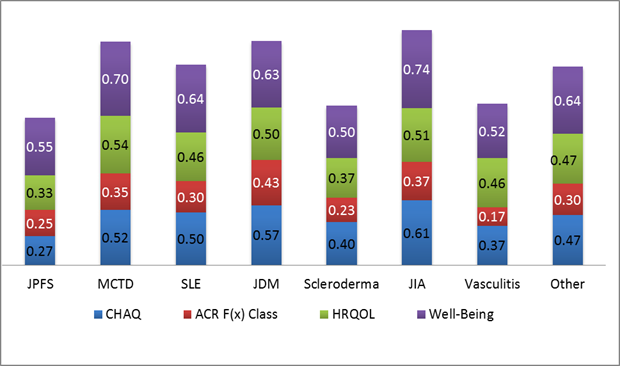Session Information
Date: Monday, November 9, 2015
Session Type: ACR Poster Session B
Session Time: 9:00AM-11:00AM
Background/Purpose: We aim to determine the extent to which pain severity differs between patients with JPFS and other rheumatic diseases and if the degree of association between pain and functioning is unique to JPFS.
Methods: We evaluated demographics, pain, functional measures (ACR functional class, current and worst, childhood (C) HAQ, health-related quality of life (HRQoL)) and health status scores from the baseline visits of patients in the CARRA Registry from 5/2010 – 6/2014. CHAQ assesses activities of daily living; 0 (no disability) to 3 (high disability). ACR functional class is a 4-point scale indicating patient’s ability to do usual self-care. HRQoL is a 5-point scale (“excellent” to “very poor”). Subjective well-being is a 0-10 scale assessing how well patient is doing considering their disease. General linear models with Dunnett’s post-hoc tests compared JPFS to other diseases on pain and function and Fisher’s r-to-z transformation compared disease groups on the correlation between pain and function.
Results: 9523 patients from infancy to 33 years (M = 12.1, SD = 4.83) (Table 1). Pain ratings were 1.8±2.6 (Vasculitis) to 6.4±2.4 (JPFS), with pain being significantly higher in the JPFS group (score 6.4/10) than any other group (effect sizes = .22 to 1.05). Ratings on disability measures were significantly worse for JPFS patients (effect sizes = .62 to 1.06) regardless of physician-rated disease severity (Fig. 1). However, the relationship between pain severity and function/disability was in most cases significantly greater for rheumatic disease patients relative to JPFS and was highest among dermatomyositis, JIA, and MCTD patients (Fig. 2).
Conclusion: JPFS is unique with regard to the perceived severity of pain and disability, yet pain appears to be comparably or more highly associated with disability in other rheumatic diseases. Given the association of pain severity with functional ability across most rheumatic diseases, regardless of disease severity, pain needs further research and increased prioritization in treatment.
Table 1. Demographic data for JPFS and disease cohorts
|
Variable |
JPFS Cohort (n = 180) |
Rheumatic Disease Cohort (n = 9343) |
|
Age (years) |
9-21 (M = 15.4, SD = 2.2) |
0-33 (M = 4.0, SD = 4.8) |
|
Sex |
85% female |
73% female |
|
Race |
86% White 6% Black/AA 8% Other |
81% White 9% Black/AA 10% Other |
|
Ethnicity |
16% Hispanic |
13% Hispanic |
|
Median income |
$75-$100,000 |
$50-$75,000 |
|
Disease type JIA SLE Dermatomyositis Localizing scleroderma CNS vasculitis MCTD Uveitis Autoinflammatory disorders Systemic sclerosis Sarcoidosis Sjögren’s syndrome Unknown |
6538 (69.0%) 1004 (11.0%) 632 (7.0%) 390 (4.1%) 192 (2.0%) 139 (1.5%) 103(1.1%) 92 (1.0%) 61 (0.6%) 49 (0.5%) 27 (0.3%) 116 (1.2%) |
Figure 1. Functional measures as a function of disease
Figure 2. Correlation coefficients (Spearman rho) for the association of pain and function across disease cohorts (higher values = greater association) 
To cite this abstract in AMA style:
Weiss JE, Connelly M. A Comparison of Pain and Disability, and Their Association Between Juvenile Primary Fibromyalgia Syndrome and Pediatric Rheumatic Diseases: Results from the Childhood Arthritis and Rheumatology Research Alliance Registry [abstract]. Arthritis Rheumatol. 2015; 67 (suppl 10). https://acrabstracts.org/abstract/a-comparison-of-pain-and-disability-and-their-association-between-juvenile-primary-fibromyalgia-syndrome-and-pediatric-rheumatic-diseases-results-from-the-childhood-arthritis-and-rheumatology/. Accessed .« Back to 2015 ACR/ARHP Annual Meeting
ACR Meeting Abstracts - https://acrabstracts.org/abstract/a-comparison-of-pain-and-disability-and-their-association-between-juvenile-primary-fibromyalgia-syndrome-and-pediatric-rheumatic-diseases-results-from-the-childhood-arthritis-and-rheumatology/

